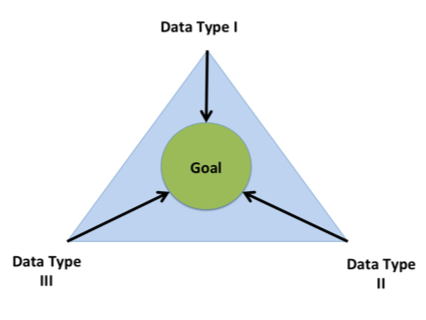
In my last article I discussed the SMART format for setting goals and the research behind Specific goals. In this article I want to discuss the next step, how you can ensure Measurable goals to achieve better results. This is arguably my favorite part of goal setting and an area where I think it is easy to get off track by establishing measurements that are less than helpful. In fact, I think in our digital world getting off track is easier than any other time in history.
The most common error I see is establishing measurements that track results, but not performance. I think in order to obtain the best results you should try to use both. The second most common error is allowing the way you decide to measure to drive your goal instead of the goal driving the way you measure. Last, I want to cover the concept of triangulation, discussing when and why you might want to use multiple measurements. Outcomes vs. Performance A simple example is the common goal to lose a specific amount of weight as part of a resolution to live a healthy life. For purposes of the example let's say you determine that you could stand to lose 10 pounds. This provides you a result or outcome that you want to achieve and you can easily monitor how your goal is progressing by using a scale to weigh yourself periodically. Still, establishing this measurement does nothing to help you as it relates to actual performance. A performance measure on the other hand is a particular action you can take that is measurable, and that you have reason to believe will help you achieve results. In trying to lose weight common methods include diet, exercise or taking a supplement. For diet you can track the number of calories you eat each day and for exercise you can track the number of calories burned or the total distance you walk or run. The supplement is a matter of tracking the frequency. These are all actions you can take that are based on some task you need to perform. From these measures or variables you can begin to tie your performance to results. As the general wisdom goes, performance drives results. Measuring What You Manage Speaking of general wisdom, management expert Edward Deming is known for his statement, "What gets measured gets managed." If you set a performance measure to eat less than 2,000 calories a day then it is this aspect of the goal to lose weight that will get managed. And management requires resources, including time and energy. Given we all have a finite amount of resources available, a sneaky trap you want to avoid is allowing a method of measurement to dictate what you will manage. Sticking with the fitness theme, a growing trend is wearable technology that helps measure all sorts of neat statistics. Fitbit is a popular brand of wearable tech, providing a wireless wristband to help track things like heart rate and even the number of flights of stairs you walk up each day. Because of these measurements, it is tempting to fall into the trap of searching for stairs you can climb or trying to develop a fitness routine to use the heart rate monitor. If you are not careful the measurement tool begins to drive what you are managing instead of the other way around. An example that is also a growing trend is the use of analytics in business. I love analytics. I think it is fun to check my websites and see people from all over the world visiting. I can see how long they have stayed on the site, what type of the device they used to connect and sometimes I even get data on age and gender. There are hundreds of analytics available from which I can choose and a mountain of data at my fingertips. It is this mountain of data that becomes the double-edged sword. You want data to help make informed decisions, but you also need to avoid letting analytics be the measure that drives your goals. Instead, you first want to use the data to inform and help establish your goals and only then select the analytics that are the correct measurement tools for the job. It is a subtle, but important difference between measuring what you manage verses managing what you measure. Triangulation Another key to measuring a goal is knowing when and why you should use more than one measurement to gauge success. We have already discussed the need to use both performance and outcome measures, but there is another concept called triangulation. The idea behind triangulation is that like the three sides of a triangle, to use three measurements to help verify and validate outcomes.
Eating less than 2,000 calories a day is performance based, the expected outcome is a loss of weight. What happens then, if after two weeks no weight has been lost? Having the single measurement weight, it would appear no progress is being made. However, if you also were measuring inches around your waist and body fat percentage, the three measurements taken together may tell a different story.
For goals that are short term, simple or low impact the added effort to manage multiple measurements is probably not worth the resources. But, for goals that are long term, complex or of high consequence, using triangulation is something to consider. For the best results, I recommend using three types of data that include both quantitative and qualitative forms of measurement. The Bottom Line A critical part of establishing a goal is to know how you plan to measure success. For better results consider: -1- Make sure to use both performance and outcome measures. -2- Measure what you manage, not the other way around. First establish your goals, then select the correct measurement for the job. -3- For goals that are complex or high consequence and long term, consider using triangulation. Select multiple measurements to validate results and keep you on the right track. To view the initial blog post on "When Setting Specific Goals is a Bad Thing", click here. About the author: Richard Feenstra is a decision researcher, studying and sharing how we make better decisions. He holds a Ph.D. in educational psychology and an M.S. in workforce development. His work experience includes military service, law enforcement, fire prevention and workplace safety. Richard is an international speaker and a recognized expert witness regarding issues of safety and security. Richard teaches a number of online courses, check out his instructor profile.
9 Comments
Ahmed Abshir dhore
8/12/2018 05:29:35 am
Thank you sir for This wonderful course.
Reply
7/18/2019 03:34:36 am
Thank you very much Sir for the valuable information in this course.
Reply
4/16/2020 12:15:30 pm
Currently doing this course. Thank you for the insight and wisdom.
Reply
Jatin
9/9/2022 10:14:28 am
Yeah, I am also doing the course and thank you for a different perspective towards goal.
Reply
Aws Nabeel
7/11/2020 12:29:20 am
I have an issue with performance mesurment for my programming skills could you please help me in a hint maybe how can i get performance assesment to my learning programming and web development ?
Reply
Azucena Ceniceros
8/4/2020 10:54:00 am
Thanks for the course!
Reply
SALIL MALLIK
9/4/2020 04:27:17 am
I have been setting up goals since ages but somehow have got them mixed up for the last several years. So what gotme to where I wanted to go now I dont know where exactly I want to go.
Reply
12/18/2021 07:53:26 am
I love this and i just want to tell to keep going and thanks for making this thinks understandable bye hope you have a great day
Reply
Your comment will be posted after it is approved.
Leave a Reply. |
Authors
Richard Feenstra is an educational psychologist, with a focus on judgment and decision making.
(read more) 
Bobby Hoffman is the author of "Hack Your Motivation" and a professor of educational psychology at the University of Central Florida.
(read more) Archives
April 2023
Categories |


 RSS Feed
RSS Feed
